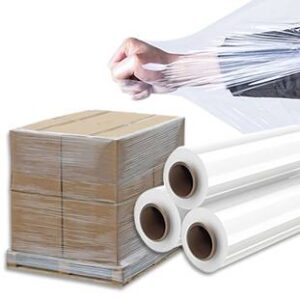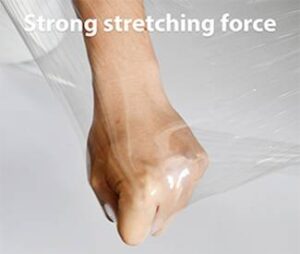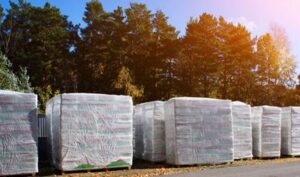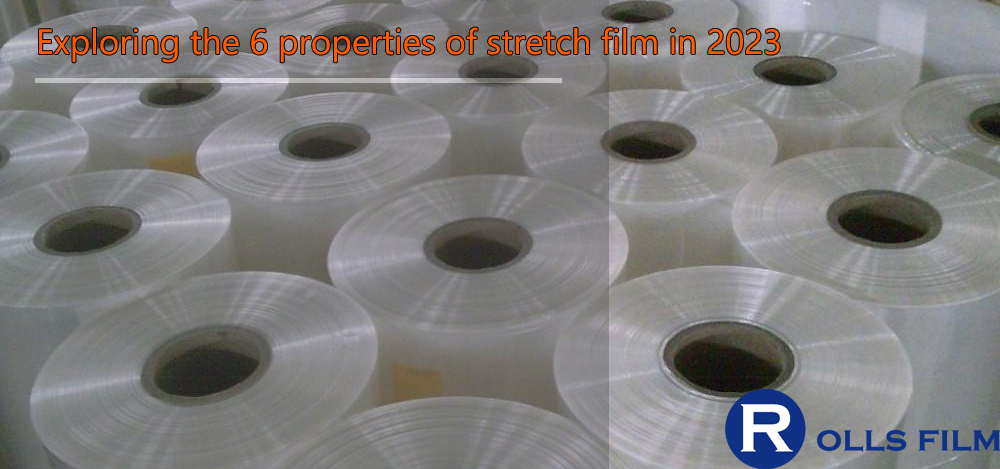In 2023’s circular economy, stretch film technology is expected to enter a new era of evolution, offering advanced solutions for packaging applications. In particular, greater clarity, strength, and durability will be achieved through the development of formulations that contain higher amounts of Linear Low-Density Polyethylene (LLDPE), which has superior puncture resistance compared to more traditional materials.
The six properties of stretch films are:
- Elasticity
- Strength and durability
- Clarity and transparency
- UV resistance
- Temperature resistance
- Static resistance
In the next sections, we give information about each of the stretch films’ properties and how it affects their performance.
Definition of stretch film

Stretch film is a highly stretchable plastic film that is used for wrapping and securing items. It is commonly made from linear low-density polyethylene (LLDPE). This type of plastic film has superior tensile strength, puncture resistance, and cling properties making it ideal for items requiring an extra layer of protection during transit or storage. The wrapping process helps to keep products protected from dust and moisture while keeping them neatly bundled together. Stretch films are available in various sizes, thicknesses, colors, and pre-stretched versions for increased efficiency. In addition, there are biodegradable options which make them more environmentally friendly than other types of packaging materials. With the right selection of stretch films, businesses can save time and money while ensuring their products are safely and securely transported to their destination.
Importance of stretch film properties
Stretch film can be a very powerful tool in the packaging process. It has many properties that make it an ideal choice for protecting and stabilizing products during transport and storage. The most important of these properties are its strength, tear resistance, puncture resistance, flexibility, cling ability, and memory retention.
Strength is perhaps the most important property of stretch film as it ensures wrapped products remain securely packaged throughout their journey from production to the customer. The greater the strength of the stretch film, the more secure and stable the package will be. Tear resistance is also an important factor as it helps to prevent accidental tearing during transit or storage. Puncture resistance is likewise a key feature, preventing sharp objects from piercing or tearing through the packaging.
Flexibility is another desirable property as it allows for the film to be stretched more than other types of packaging materials to wrap around and secure even irregularly shaped items. Clingability, meanwhile, helps ensure the film stays in place once applied, providing extra security and stability. Memory retention ensures that the stretch film returns to its original shape after being stretched, making it easier to work with and helping to reduce waste.
These are just some of the key properties that make the stretch film such a useful packaging material.
Stretch film properties
Elasticity

Elasticity plays a key role in the performance of stretch films. This is because elastic recovery affects the amount of force required to stretch and apply the film, as well as its ability to return to its original structure after being stretched. Additionally, elasticity also influences the film’s ability to withstand punctures, tears, and other damages. This is why the manufacturer needs to ensure that their stretch film has the right degree of elasticity for their desired application. The stretchability of a given film can be measured by its elongation percentage, which describes how much the material stretches before breaking or reaching a set limit point. A higher elongation percentage indicates a higher elasticity, while a lower elongation percentage corresponds to a less elastic film.
Strength and durability

Stretch films are increasingly becoming the preferred choice of packaging for multiple industrial and consumer goods due to their superior strength and durability. The stretch film provides a strong, secure, and cost-effective protective layer for items in storage or transit. It is also highly resistant to tears, punctures, and moisture damage. Additionally, its ability to conform tightly to an object ensures that it can be secured from any external force. With these advantages, stretch films are often the material of choice for various applications such as product protection, palletizing goods, shipping items, etc. Furthermore, it contributes significantly towards waste reduction as it requires less material than other packaging materials like paper or plastic bags. Thus, using stretch films results in reduced costs associated with labor and resources while providing maximum protection. Therefore, it is the ideal option for businesses that require reliability and efficiency while providing optimal protection for their products.
Clarity and transparency

Stretch films provide excellent clarity and transparency, which is ideal for displaying product information. The film’s high-clarity performance allows users to clearly read labels on packages and quickly identify the contents inside. Additionally, the transparent nature of stretch films also makes products immediately visible upon delivery or in-store display, allowing customers to make informed decisions when selecting a product. With these features, stretch films represent an invaluable tool in helping businesses optimize their operations and provide better customer experiences.
The clarity and transparency of stretch films also support important safety protocols. By enabling users to quickly identify the contents of packages, companies can ensure that the right items are being shipped and delivered to their customers. This prevents the incorrect packing of hazardous materials, which can lead to a variety of safety risks.
UV resistance

Cast stretch film is a highly effective tool for keeping products secure during transit, but the effectiveness of stretch film can be diminished significantly if it does not offer adequate protection against Ultraviolet (UV) radiation. UV radiation from sunlight and other sources can cause the stretch film to degrade more quickly than normal, leading to reduced strength and increased permeability. This makes it essential for any stretch film used in transportation applications to have a high degree of UV resistance.
Fortunately, stretching technology has advanced tremendously over recent years, allowing manufacturers to produce films that are far more resistant to UV degradation than ever before. For instance, some manufacturers now use specialized additives or coatings on their stretch films that provide superior levels of protection against the damaging effects of UV radiation.
Temperature resistance

Another important factor to consider when selecting stretch film is its temperature resistance.
Temperature resistance refers to the ability of a material to maintain its structural integrity when exposed to extreme temperatures. Stretch film is manufactured with a variety of materials, each with different temperature resistance requirements. Polyethylene (PE) and Polypropylene (PP) stretch films are commonly used in applications where temperature resistance is important. These materials offer high-temperature resistance and can withstand temperatures up to 120°F.
It is important to select the right stretch film for your application based on its temperature resistance requirements. However, it is also important to note that exposure of stretch films to extreme temperatures over long periods can weaken their strength and flexibility. This can reduce their effectiveness as a wrapping material, so it is important to consider the environmental conditions that the stretch film will be subject to during use.
Static resistance

Static resistance is an important factor to consider when selecting a stretch film. This measure indicates the product’s ability to prevent the buildup of static electricity, reducing its attraction to dust, dirt, and other contaminants. Additionally, a higher static resistance can help reduce worker discomfort due to electric shocks when handling stretched plastic wrap. The standard unit of measurement for this type of property is ohms per square (ohms/square). The higher the number, the better resistance it offers against static electricity. It is important to consider that different types of stretch film can offer different levels of static resistance. Therefore, when choosing a product for a specific application, make sure to check its ohms per square rating and choose an appropriate option.
How the stretch film’s properties affect its performance
1.Elasticity and stretchability
Stretch film’s elasticity and stretchability are key factors in determining its performance. Elasticity is the ability of a material to return to its original shape after being stretched or compressed, while stretchability is the amount by which a material can be stretched before breaking. The higher the elasticity and stretchability of a stretch film, the better it will perform when wrapping and securing loads. Stretch films with high elasticity will not only conform tightly around products for maximum stability but also provide greater protection from moisture, dust, punctures, and other external elements. A higher degree of stretchability also means that fewer wraps are needed around each load, saving time while ensuring load integrity.
2.Strength and durability
Strength and durability are important criteria that impact the performance of the stretch film. Film strength is measured by its ability to resist puncture, tear, and break when stretched to the limit. The more resistant it is, the less likely it is to fail during the application or in transit. Durability refers to a film’s resistance to environmental conditions such as sunlight, precipitation, fluctuating temperatures, and wind. Films with higher levels of durability last longer in harsh conditions without compromising their properties like cling or tensile strength. Both factors contribute to the overall performance of the stretch film, helping it last longer and continue to protect its contents.
3.Clarity and transparency
Clarity and transparency play key roles in the performance of the stretch film. Clarity refers to how clear or transparent a film is, which affects the ability of a consumer to see the product it is protecting. The clearer and more transparent a film are, the better visibility there will be in the product. This helps ensure that customers can easily see products on display before they make their purchase decisions.
Transparency also vastly affects stretch film’s performance by contributing to increased levels of protection against dust, dirt, moisture, and other contaminants while keeping products safe from tampering during shipping and handling. With greater clarity, it’s easier to determine if any damage occurred during transportation or while in storage so you can quickly take corrective action.
4.UV resistance and protection
UV rays can cause several issues when it comes to stretch film performance. UV-resistant and protected films are designed to reduce the effects of UV light on the plastic, which helps extend its lifespan as well as maintain its strength and clarity. These types of films often come with an outer layer that is treated to be able to reflect or absorb UV radiation, while also improving heat stability and preventing weathering. This means that they are better able to withstand outdoor elements such as sunlight, wind, rain, and extreme temperatures without weakening or becoming opaque. Furthermore, these protective layers help reduce the risk of shrinkage due to exposure to direct sunlight, ensuring your stretch film remains tight and secure over time.
5.Temperature resistance and stability
Temperature resistance and stability are important factors in understanding the performance of the stretch film. Temperature affects the amount of tension that can be applied to a palletized load, as well as the degree of shrinkage and stretching. As temperature increases, so does the flexibility of the film, allowing it to better conform to irregular surfaces and achieve maximum tension on a palletized load. Conversely, when temperatures drop, the film becomes more rigid and less able to stretch or conform around an irregular surface. Poor temperature stability may also lead to premature failure of the film over time due to excessive shrinkage or stretching. Proper selection of stretch films with adequate temperature resistance ensures optimal performance and will help avoid any potential problems associated with improper use or application.
6.Static resistance and safety
When it comes to safety and static resistance, the stretch wrap plays an important role in the transportation of goods. By covering palletized loads with a layer of plastic film, static electricity is prevented from accumulating on the surface of the load, which can lead to combustible or flammable materials igniting due to sparks. Additionally, this protective layer helps prevent any potential contamination that could occur while cargo is being transported and stored. Furthermore, the stretch film provides an extra level of protection against damage or theft; stretching the material tightly around a palletized load creates a tamper-proof barrier that keeps cargo secure. All these benefits demonstrate why the stretch film is essential for protecting goods during transit and storage.
Conclusion
In conclusion, the stretch film of 2023 will be a highly advanced form of packaging material. It will offer the supply chain improved strength and puncture resistance due to the use of nanotechnology-enhanced materials; exceptional holding power through its high stretchability; better impact protection with its conformable nature; and increased optical clarity, allowing industry leaders to get an unobstructed view of the product beneath. Furthermore, these products are also expected to be more sustainable and eco-friendly due to their lighter weight and recyclable properties. All in all, the advancements in stretch film technology are sure to revolutionize and impact the increasing demand of the packaging industry in the near future.














